Dtc Check / Clear
DTC CHECK / CLEAR
CHECK DTC (CHECK USING TECHSTREAM)
(a) Connect the Techstream to the DLC3.
(b) Turn the engine switch on (IG) and wait for 90 seconds.
(c) Turn the Techstream on.
(d) Enter the following menus: Body Electrical / Navigation System / Trouble Codes.
Body Electrical > Navigation System > Trouble Codes
(e) Check for DTCs, and then write them down.
(f) Check the details of the DTC(s).
Click here 
NOTICE:
The
navigation system outputs DTCs for the following system. When DTCs
other than those in Diagnostic Trouble Code Chart for the navigation
system are output, refer to Diagnostic Trouble Code Chart for the
relevant system.
|
System | Proceed to |
|
Parking Assist Monitor System |
 |
CLEAR DTC (CLEAR USING TECHSTREAM)
(a) Connect the Techstream to the DLC3.
(b) Turn the engine switch on (IG) and wait for 90 seconds.
(c) Turn the Techstream on.
(d) Enter the following menus: Body Electrical / Navigation System / Trouble Codes.
Body Electrical > Navigation System > Clear DTCs
(e) Clear the DTCs.
START DIAGNOSTIC MODE
HINT:
- Illustrations may differ from the actual vehicle screen depending on the
device settings and options. Therefore, some detailed areas may not be
shown exactly the same as on the actual vehicle screen.
- If the system cannot enter diagnostic mode, inspect all AVC-LAN
communication components and repair or replace the malfunctioning parts.
Click here 
- Start diagnostic mode at least 90 seconds after turning the engine switch on (IG). Otherwise, some items cannot be checked.
(a) There are 4 methods to start diagnostic mode. Start diagnostic mode by using one of them.
(b) Method 1
(1) Turn the engine switch on (IG).
(2) While pressing and holding the "AUDIO" switch, operate the light control switch: Off → Tail → Off → Tail → Off → Tail → Off.
(3) Diagnostic mode will start and the "Service Menu" screen will be displayed.
(c) Method 2
(1) Connect the Techstream to the DLC3.
(2) Turn the engine switch on (IG).
(3) Turn the Techstream on.
(4) Enter the following menus: Body Electrical / Navigation System / Utility / Diagnostic Mode.
Body Electrical > Navigation System > Utility
|
Tester Display |
| Diagnostic Mode |
(5) Diagnostic mode will start and the "Service Menu" screen will be displayed.
(d) Method 3
(1) Turn the engine switch on (IG).
(2)
Press the seek/track up panel switch 5 times and then press the
seek/track down panel switch 5 times with the screen and audio turned
off.
HINT:
- Diagnostic mode can only be started if the above operation is completed
within 15 seconds of the first press of the seek/track up panel switch.
- If the operation is not completed within 15 seconds of the first press
of the seek/track panel switch or fails, turn the screen and audio on
and then off again before attempting to start diagnostic mode.
(3) Diagnostic mode will start and the "Service Menu" screen will be displayed.
(e) Method 4
NOTICE:
- Do not touch the multi-display except when necessary.
- Since the multi-display may recognize a pinch in/out or flick operation
if operated with 2 fingers, always use 1 finger to operate it in
diagnostic mode.
(1) Turn the engine switch on (IG).
(2)
Perform a flick operation on the multi-display screen from the left to
the right 5 times and then perform a flick operation from the right to
left 5 times with the screen and audio turned off as shown in the
illustration.
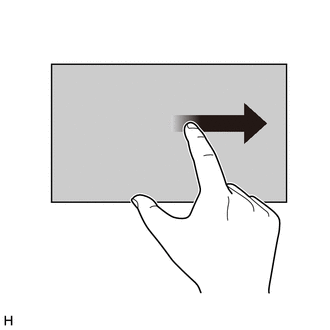
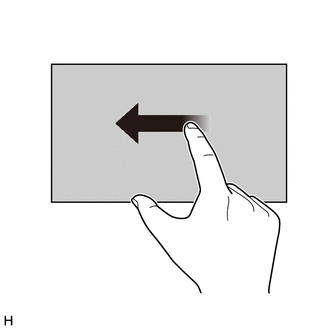
HINT:
- Diagnostic mode can only be started if the above operation is completed
within 15 seconds of the first flick from the left to the right.
- If the operation is not completed within 15 seconds of the first flick
from the left to the right or fails, turn the screen and audio on and
then off before attempting to start diagnostic mode again.
- Flick operations can be recognized anywhere within the touch area of the multi-display screen.
(3) Diagnostic mode will start and the "Service Menu" screen will be displayed.
FAILURE DIAGNOSIS
(a) The "Failure Diagnosis" screen will be displayed by selecting "Failure Diagnosis" on the "Service Menu" screen.
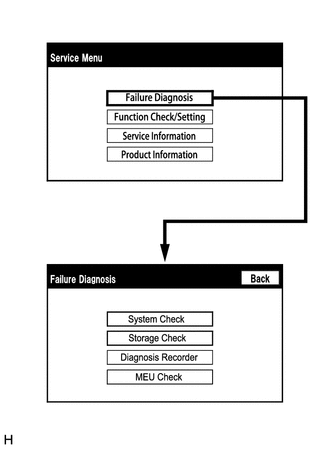
SYSTEM CHECK
(a) The "System Check Mode" screen will be displayed by selecting "System Check" on the "Failure Diagnosis" screen.
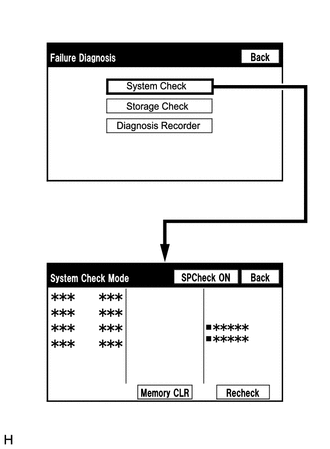
CHECK DTC (CHECK USING SYSTEM CHECK MODE SCREEN)
HINT:
When
"NCON" is displayed for all devices connected via AVC-LAN
communication, or when all device names are not displayed, check if
there is a short in an AVC-LAN line or device connected to the AVC-LAN.
Repair or replace parts as necessary.
Click here

(a) System check mode screen description
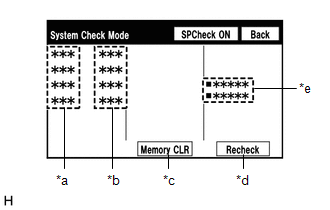 Screen Description
Screen Description |
Display | Content |
|
*a: Device name list No. 1 |
- Device Name List No. 1 displays some of the devices that make up the navigation system.
- The names of the components from Device Name List No. 1 are shown in the following table.
|
| *b: Check result |
Result codes for all devices are displayed. |
|
*c: Memory clear |
- Present and history DTCs and registered connected device names are cleared.
- Select "Memory CLR" for 3 seconds.
|
| *d: Recheck |
- A system check will be performed again after the memory is cleared.
- "Recheck" will dim during a system check.
|
| *e: Device name list No. 2 |
- Device Name List No. 2 displays some of the devices that make up the navigation system.
- The names of the components from Device Name List No. 2 are shown in the following table.
|
*a: Device Name List No. 1 Description |
Name | Component |
Connection Method |
|
DCU | Radio and display receiver assembly |
- |
| DSP-AMP |
Stereo component amplifier assembly |
AVC-LAN communication line |
|
MEU | Navigation ECU |
USB communication line |
|
CAA | Television camera assembly*1 |
Vehicle wire harness |
|
CAMERA-M | Television camera controller*2 |
Vehicle wire harness |
- *1: w/o Panoramic View Monitor System
- *2: w/ Panoramic View Monitor System
*b: Check Result Description |
Result | Meaning |
Action |
| OK |
The device does not respond with a DTC. |
- |
| DETAIL |
The device responds with a DTC. | Read the DTCs on the "Unit Check Mode" screen. |
|
NCON | The device was previously present, but did not respond in diagnostic mode. |
- Check the vehicle wire harness.
- Check the power supply circuit of the device.
- Check the AVC-LAN communication line of the device.
|
| NRES |
The device responded in diagnostic mode, but gives no DTC information. |
*e: Device Name List No. 2 Description |
Name | Component |
Connection Method |
|
DCM | DCM (telematics transceiver)* |
USB communication line |
|
AUX/VTR | Stereo jack adapter assembly |
Vehicle wire harness |
- *: w/ Manual (SOS) Switch
(b) Unit check mode screen description
Screen Description |
Display | Content |
|
*a: Device name | Target device |
|
*b: History DTC | Diagnostic memory results and stored DTCs are displayed. |
|
*c: Present DTC | DTCs output in the service check are displayed. |
|
*d: DTC | DTC (Diagnostic Trouble Code) |
|
*e: Timestamp* | The time and date of history DTCs are displayed. (The year is displayed in 2-digit format.) |
|
*f: Diagnosis clear | Selecting
"Code CLR" for 3 seconds clears the diagnostic memory data of the
target device (both diagnostic system check result and the displayed
data are cleared). |
- *: w/ GPS Time Setting Function
HINT:
- This screen is updated once per second.
- A maximum of 6 DTCs can be displayed for history and present DTCs.
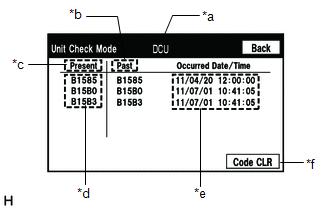
(c) Read the system check result.
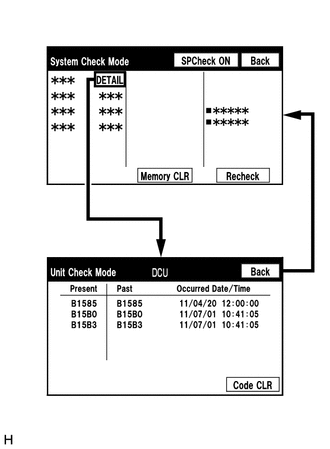
(1)
If the check result is "DETAIL", select the displayed check result to
view the results on the "Unit Check Mode" screen and record them.
NOTICE:
A
maximum of 6 DTCs can be displayed for history and present DTCs on the
"Unit Check Mode" screen. Therefore, when 6 DTCs are displayed,
troubleshoot those DTCs first and then check the "Unit Check Mode"
screen again to see if any other DTCs are displayed.
HINT:
- When all results are "OK", no DTCs are present.
- When proceeding to view the results of another device, select "Back" to
return to the "System Check Mode" screen. Repeat the above step to view
the results of other devices.
(2) Check the details of the DTC(s).
Click here

NOTICE:
The
navigation system outputs DTCs for the following system. When DTCs
other than those in Diagnostic Trouble Code Chart for the navigation
system are output, refer to Diagnostic Trouble Code Chart for the
relevant system.
|
System | Proceed to |
|
Parking Assist Monitor System |
 |
DTC CLEAR/RECHECK (CLEAR USING SYSTEM CHECK MODE SCREEN)
(a) Clear the DTCs
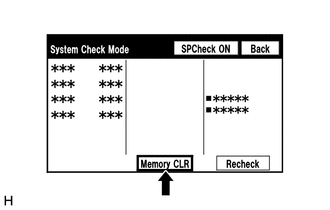
(1) Select "Memory CLR" for 3 seconds.
(2) Check that the check results are cleared.
HINT:
- To clear the DTCs for a specific device, use the "Unit Check Mode" screen.
- When clearing the DTCs using the "Unit Check Mode" screen, select "Code CLR" for 3 seconds.
(b) Recheck
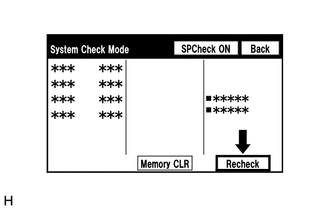
(1) Select "Recheck".
(2)
Check that all diagnostic codes are "OK" when the check results are
displayed. If a result other than "OK" is displayed, perform
troubleshooting again.
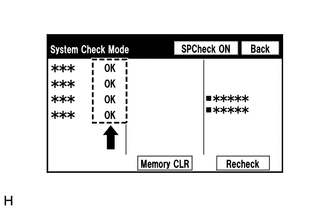
HINT:
When
the DTCs are cleared using the "Unit Check Mode" screen, select "Back"
to return to the "System Check Mode" screen and perform this operation.
FINISH DIAGNOSTIC MODE
(a) Turn the engine switch off.
How To Proceed With Troubleshooting
CAUTION / NOTICE / HINT
HINT:
- Use the following procedure to troubleshoot the navigation system.
- *: Use the Techstream.
PROCEDURE
|
1. | VEHICLE BROUGHT TO WORKSHOP |
|
NEXT |
 | |
| 2. |
CUSTOMER PROBLEM ANALYSIS |
- When troubleshooting, check that the problem symptoms have been
accurately identified. Preconceptions should be discarded in order to
make an accurate judgment. To clearly understand what the problem
symptoms are, it is extremely important to ask the customer about the
problem and the conditions at the time the malfunction occurred.
- Gather as much information as possible for reference. Past problems that seem unrelated may also help in some cases.
- The following 5 items are important points for problem analysis:
|
What |
Vehicle model, system name |
|
When |
Date, time, occurrence frequency |
|
Where |
Road conditions |
|
Under what conditions? |
Driving conditions, weather conditions |
|
How did it happen? |
Problem symptoms |
|
NEXT |
 | |
(a) Measure the battery voltage.
Standard Voltage:
11 to 14 V
HINT:
If the voltage is below 11 V, recharge or replace the battery before proceeding to the next step.
|
NEXT |
 | |
(a)
Check that condensation is not likely to occur in the cabin and that
the temperature is not high or extremely low in the cabin.
OK:
Condensation is not likely being produced and the temperature is not high or extremely low.
HINT:
- A humid cabin and a rapid change in temperature may lead to condensation. Condensation in the cabin may cause a short circuit.
- The navigation system may not operate normally when the temperature is -20°C (-4°F) or lower, or 65°C (149°F) or higher.
| NG |
 | SET CABIN TO APPROPRIATE TEMPERATURE |
|
OK |
 | |
| 5. |
CHECK NAVIGATION SYSTEM NORMAL CONDITION |
(a) Refer to Check System Normal Condition.
Click here

|
Result | Proceed to |
|
Symptom is not normal operation. |
A |
| Symptom is normal operation. |
B |
| B |
 | END |
|
A |
 | |
| 6. |
CHECK CAN COMMUNICATION SYSTEM* |
(a) Check if CAN communication system DTCs are output.
Click here 
|
Result | Proceed to |
|
CAN DTCs are not output. |
A |
| CAN DTCs are output. |
B |
| B |
 | GO TO CAN COMMUNICATION SYSTEM |
|
A |
 | |
(a) Check for DTCs.
Body Electrical > Navigation System > Trouble Codes
|
Result | Proceed to |
|
DTCs are output. | A |
|
DTCs are not output. |
B |
| B |
 | GO TO STEP 11 |
|
A |
 | |
(a) Clear the DTCs.
Body Electrical > Navigation System > Clear DTCs
HINT:
The present DTCs may not indicate actual malfunctions depending on the vehicle operating conditions.
|
NEXT |
 | |
(a) Recheck for DTCs.
Body Electrical > Navigation System > Trouble Codes
|
Result | Proceed to |
|
DTCs are output. | A |
|
DTCs are not output. |
B |
HINT:
- Even if the problem symptom is not confirmed, check for DTCs. This is because the system stores history DTCs.
- If more information is needed, perform a recheck using the "System Check
Mode" screen after rechecking for DTCs using the Techstream.
- Check for DTCs and inspect the area that the code indicates.
| B |
 | GO TO STEP 11 |
|
A |
 | |
| 10. |
DIAGNOSTIC TROUBLE CODE CHART |
(a) Find the output DTC in Diagnostic Trouble Code Chart.
Click here 
| NEXT |
 | GO TO STEP 13 |
| 11. |
PROBLEM SYMPTOMS TABLE |
(a) Refer to Problem Symptoms Table.
Click here 
|
Result | Proceed to |
|
Fault is not listed in Problem Symptoms Table. |
A |
| Fault is listed in Problem Symptoms Table. |
B |
HINT:
If the symptoms do not recur and no DTCs are output, attempt to reproduce the symptoms.
Click here 
| B |
 | GO TO STEP 13 |
|
A |
 | |
| 12. |
PERFORM TROUBLESHOOTING BASED ON PROBLEM SYMPTOM |
(a) Refer to Terminals of ECU.
Click here

|
NEXT |
 | |
(a) Adjust, repair or replace as necessary.
|
NEXT |
 | |
(a) After clearing DTCs, recheck for DTCs.
Body Electrical > Navigation System > Clear DTCs Body Electrical > Navigation System > Trouble Codes
|
NEXT |
 | |
| 15. |
PERFORM CONFIRMATION TEST |
| NEXT |
 | END |








 Screen Description
Screen Description 
































